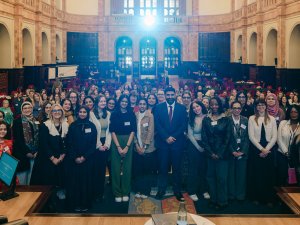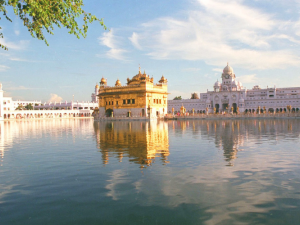Sahibzada Ajit entered the world on *January 12, 1687 A.D., at Paonta Sahib, born to Mata Sundari, the second wife of the babe’s father, Guru Gobind Rai, Tenth Guru of the Sikhs. The household wholeheartedly welcomed their first prince with greatest joy.
Seven months after the martyrdom of his father Ninth Guru Tegh Bahadur, Guru Gobind Rai, born 22 December 1666, at the age of just nine and a half years, wed his betrothed, Jito, daughter of Hari Jas, on June 21, 1677. Seven years passed without the young couple conceiving a child.
The Guru’s widowed mother Mata Gurjari, urged her son to take a second wife in order to ensure the family lineage and preserve alliances. At the age of 17, Guru Gobind Rai wed Sundari, daughter of Ram Saran, on April 4, 1684. Three and a half years passed. Then at age 20, the Tenth Guru became a father for the first time when his second wife Sundari gave birth to their son Sahibizada Ajit.
In subsequent years, Guru ji’s first wife, Jito, conceived and blessed her husband with three sons, and Ajit with three cherished younger brothers, Sahibzade Jujhar, Zarowar, and Fateh.
Education
The family left Paonta the year following Ajit’s birth and relocated to Anandpur where the Sahibzade received an education befitting a prince. He studied history and philosophy along with being tutored in religious ideology and scriptures. He also received military training in horsemanship, and weaponry, learning how to excel in use of a sword, bow, and arrow. Ajit grew to be strong and handsome. His younger brothers admired and looked up to him, and he became popular as a leader among his peers.
Initiation
Sahibzada Ajit became initiated as a Khalsa warrior at 12 years of age during the Vaisakhi festivities of April 1699. His father Guru Gobind Rai founded the Khalsa as an established order April 13th, and received initiation along with all of his family. Upon drinking the immortal nectar of Amrit administered by the five beloveds, or Panj Pyare, the Guru and his sons, along with all male initiates, received the name of Singh. Forever after, the Guru became known as Guru Gobind Singh and Sahibzade Ajit known as Sahibzade Ajit Singh.
Military Engagements
Sahibzade Ajit Singh began engaging in military encounters soon after his initiation as a Khalsa Warrior.
1699
May – June: Sahibzade Ajit Singh had his first real test of mettle and military skill shortly after his initiation rites. A convoy of Sikhs who had been traveling to Anandpur from Pothohar in the Northwest region of Punjab had been waylaid, ransacked, and robbed on the far side of River Sutlej by the Rangars of Nuh, a Muslim sect who revered the prophet Noh. Guru Gobind Singh appointed Ajit Singh to lead a company of 100 Sikhs to the village of the raiders, to recover the stolen goods. Ajit Singh, at age of only 12 years, handled his venture with utmost responsibility. With the aid of his companions at arms, Ajit Singh secured the return of all looted items.
1700
August – September: Hill Rajas concerned with the Guru’s growing popularity colluded with Mughal Imperial troupes to attack Anandpur. Guru Gobind Singh appointed Sahibzade Ajit Singh, to command the first line of defense at Taraghar fort in Anandpur. Aided by Bhai Udai Singh, a veteran of warfare, and other courageous warriors, the Sikhs successfully repelled their enemy.
October: Sahibzade Ajit Singh showed courage and displayed great valor in the battles at Nimoghar while fighting off the Hill Chieftains’ continual assaults on the Sikhs.
1701
March: Gujjars and Rangars colluded to intercept and raid a caravan of Sikh devotees traveling from Darap (present day Sialkot) to Anandpur. The raiders carried off all of the traveler’s belongings including gifts and offerings meant for the Guru’s court. Upon learning of the foray, Guru Gobind Singh dispatched Sahibzada Ajit Singh with a band of warriors to punish the plunderers. Ajit Singh and his army laid siege to the raider’s village Bajrur, captured, and executed Chittu and Mitta, the chief ringleaders of the raid.
1703
A Pathan chieftain forcefully abducted the wife of a newly wedded Brahmin who appeared at the court of Guru Gobind Singh and informed Guru ji that his wife had been stolen from him by a band of Pathans from Bassi nearby Hoshiarpur. Guru Ji directed Sahibzade Ajit Singh to take over 100 warriors on horseback and mount a rescue mission to retrieve the Brahmin’s wife. During the dark of night, the Sikh warriors attacked Bassi, recovered the Brahmins wife, restored her safety, and delivered her to her grateful husband. The Sikhs arrested those responsible for the abduction, and took them to Anandpur where they received severe penalties and punishments for their malicious acts.
1704 – 1705
Siege of Anandpur: Continual harassment of the Sikhs by Hill Chief Rajas and their Mughal allies resulted in ongoing battles during a prolonged siege of Anandpur. Guru Gobind Singh divided his forces between six strong holds at Anandpur. He put his 15-year-old second eldest son Sahibzada Jujhar Singh in charge of the fortification Lohghar. The Guru made eldest son Sahibzada Ajit Singh, commander of the fortress Keshghar, where on his first day of command, he successfully repelled an attack and slew Jagatullah, the leader of a combined Gurjjar and Rangar onslaught.
1705
December 5-6 Evacuation of Anandpur: The besieged and starving Sikhs agreed to a promise of safe passage out of Anandpur. Expecting treachery, Guru Gobind Singh put Sahibzada Ajit Singh in charge of a rear guard as the Sikhs fled Anandpur in the dark of night to cross the dangerous turbulent raging waters of the flooded River Sarsa. Ajit Singh fought alongside Bhai Bachittar Singh a for more than two and a half hours at Shahi Tibbi, holding back the treacherous enemy horde as the Sikhs struggled to escape. The Guru Sent Bhai Udai with 50 warriors to relieve Ajit Singh and Bhai Bachittar, and sent them with another hundred warriors to patrol the left bank of river Sutlej to ensure the safety of Sikhs who had taken that route. The warriors encountered Rangars from Malikpur and Pathans from Ropar. A great many Sikhs achieved martyrdom in the fierce fighting that followed. Ajit Singh carried mortally wounded Bhai Bachittar to Kotla where he met his father at the house of Nihang Khan. Guru Gobind Singh Left Kotla with his two elder sons Sabhizade Ajit Singh & Jujhar Singh along with 40 of his most faithful warriors. With the enemy in close pursuit, the Guru, his sons, and warriors crossed River Sarsa and took refuge in a mudwalled compound in Chamkaur.
December 7 Martrydom at Chamkaur: A horde of 100,000 foot soldiers and 700 horse soliders comprised of Gujjars, Rangars, and Mughal reinforcements from Malerkotla surrounded the mud walls of the fortress at Chamkaur Ghari. Guru Gobind Singh, his sons, and warriors fought ferociously, sacrificing their lives rather than surrender to the demands that they renounce their faith to embrace Islam. Forty faithful warriors, Shaibzade Ajit Singh, not yet 19, and Sahibzade Jujhar Singh still only 15, defied the ultimatums of their cowardly enemy. Undaunted by the sheer numbers of forces facing them, they remained steadfastly fearless to their last breath. Leaving their mudded walls of refuge a few at a time, the courageous Sikhs swept out into the midst of the horde using naught but sword and spear to reap the lives of their adversaries, who fell the way blades of grass fall before the blade of a sickle.
Enemy chroniclers described the frenzied assault of the Sahibzade and Sikh warriors as “Crocodiles parting water,” and likened the tens of thousands Mughal ranks of which fell slain on the field of battle before the 40 martyred warriors breathed their last, to “drops of rain that fall during season of monsoon.”
*Date of Ajit Singhs births has been converted from January 26th of the Julian calendar C.E. to February 12th of the Gregorian calendar A.D., with a difference of an additional 17 days.





